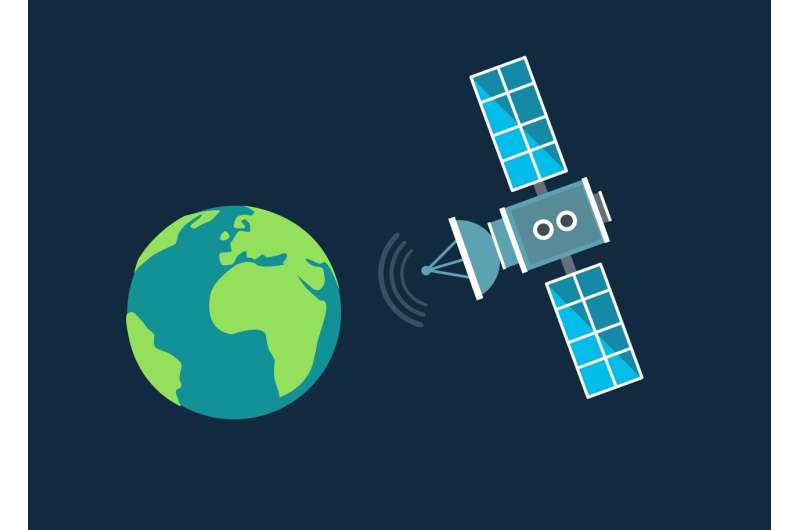Low Earth Orbit
(LEO) Satellite: Palomar survey instrument analyzes impact of
Starlink satellites

Since 2019,
SpaceX has been launching an increasing number of internet
satellites into orbit around Earth. The satellite constellation,
called Starlink, now includes nearly 1,800 members orbiting at
altitudes of about 550 kilometers. Astronomers have expressed
concerns that that these objects, which can appear as streaks in
telescope images, could hamper their scientific observations.
To quantify these effects, a team of researchers studied archival
images captured by the National Science Foundation (NSF)-funded
Zwicky Transient Facility (ZTF), an instrument that operates from
Caltech's Palomar Observatory near San Diego. ZTF scans the entire
night sky every two days, cataloging cosmic objects that explode,
blink, or otherwise change over time. This includes everything from
supernovae to near-Earth asteroids. The Zwicky team members say they
decided to specifically study the effects of Starlink satellites
because they currently represent the largest low-Earth orbit, or
LEO, constellation, and they have well-characterized orbits.
The findings, reported in the January 17 issue of The Astrophysical
Journal Letters, shows 5,301 satellite streaks appear in archival
images taken between November 2019 and September 2021. The streaks
are most apparent in so-called twilight observations, those taken at
dawn or dusk, which are important for finding near-Earth asteroids
that appear close to the sun in the sky. ZTF has discovered several
asteroids of this nature, including 2020 AV2, the first asteroid
spotted with an orbit that fits entirely within the orbit of Venus.
"In 2019, 0.5 percent of twilight images were affected, and now
almost 20 percent are affected," says Przemek Mrůz, study lead
author and a former Caltech postdoctoral scholar who is now at the
University of Warsaw in Poland.
In the future, the scientists expect that nearly all of the ZTF
images taken during twilight will contain at least one streak,
especially after the Starlink constellation reaches 10,000
satellites, a goal SpaceX hopes to reach by 2027.
"We don't expect Starlink satellites to affect non-twilight images,
but if the satellite constellation of other companies goes into
higher orbits, this could cause problems for non-twilight
observations," Mrůz says.
Yet despite the increase in image streaks, the new report notes that
ZTF science operations have not been strongly affected. Study
co-author Tom Prince, the Ira S. Bowen Professor of Physics,
Emeritus, at Caltech, says the paper shows a single streak affects
less than one-tenth of a percent of the pixels in a ZTF image.
"There is a small chance that we would miss an asteroid or another
event hidden behind a satellite streak, but compared to the impact
of weather, such as a cloudy sky, these are rather small effects for
ZTF."
Prince says that software can be developed to help mitigate
potential problems; for example, software could predict the
locations of the Starlink satellites and thus help astronomers avoid
scheduling an observation when one might be in the field of view.
Software can also assess whether a passing satellite may have
affected an astronomical observation, which would allow astronomers
to mask or otherwise reduce the negative effects of the streaks.
The new study also looked at the effectiveness of visors on the
Starlink satellites, which SpaceX added beginning in 2020 to block
sunlight from reaching the spacecraft. According to the ZTF
observations, the visors reduce the satellite brightness by a factor
of about five. That dims the satellites down to an apparent
brightness level of 6.8 magnitude (the brightest stars are first
magnitude, and the faintest stars we can see with our eyes are about
sixth magnitude).
This is still not dim enough to meet standards outlined by the
Satellite Constellations 1 (SATCON1) workshop in 2020, a gathering
sponsored by the NOIRLab (National Optical-Infrared Astronomy
Research Laboratory) and the AAS (American Astronomical Society) to
bring together astronomers, policymakers, and other experts to
discuss the impact of large satellite constellations on astronomy
and society. The group called for all LEO satellites to be at
seventh magnitude or fainter.
The study authors also note their study is specific to ZTF. Like ZTF,
the upcoming Vera C. Rubin Observatory, under construction in Chile,
will also survey the sky nightly, but due to its more sensitive
imager, astronomers predict that it may be more negatively affected
by satellite streaks than ZTF.
California
Institute of Technology
TACS is
a leading top consultancy in the field of Fixed
or Mobile Wireless Satellite Systems and Networks.
TACS
consultants are the first inventors of fixed or mobile packet
radio structures in the world for 2G, 3G, 4G, 5G and 6G wireless
systems.
TACS is
Pioneer and Innovator of many Communication Signal Processors,
Optical Modems, Radio Modems, 5G Modems, 6G Modems, Satellite
Modems, PSTN Modems, Cable Modems, PLC Modems, and more..
|
TACS
- Delivers the insight and vision
on technology for strategic decisions on Wireless Systems.
- Assesses technologies and standards and develops
architectures for Wireless Systems.
- Provides
the energy and experience of world-wide leading innovators and experts in
Wireless Systems.
|